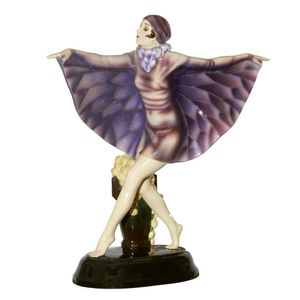Goldscheider Butterfly Girl Earthenware Figure by Josef Lorenzl
'Butterfly girl (Captured Bird)' a Goldscheider earthenware figure by Josef Lorenzl (Austrian, 1892-1950), circa 1920, modelled as a woman wearing a cape-like dress, hand painted and glazed, printed and impressed factory marks: 5230 / 1813 / 11, underglazed mark to base: Hand-Decorated / Goldscheider / Wien / made in Austria, height 46 cm, Literature: Robert Dechant & Filipp Goldscheider, Goldscheider: history of the Company and catalogue of works, Arnoldsche, Stuttgart, 2007, p. 420 (another example). Other Notes: Celebrated Austrian sculptor and ceramicist Josef Lorenzl's graceful representations of the female form were in high demand in the early 20th century. This depiction of famous German dancer Niddy Impekoven is particularly sought-after by Collectors for its sense of movement, and use of clean lines and geometric shapes which embodied Lorenzl's mature period when he created pieces for Austrian ceramics Company Goldscheider. Niddy wears her hair in the bob that was fashionable in the 1920s, and performs her signature expressionistic style of dance with arms outstretched in a richly coloured butterfly costume (resulting in this piece also being known as 'The butterfly Girl'). This costume was one of her most memorable, worn for her dance 'Der gefangene Vogel' (the Captured bird) which she would go on to perform internationally as one of the most iconic dancers of the golden Twenties.
You must be a subscriber, and be logged in to view price and dealer details.
Subscribe Now to view actual auction price for this item
When you subscribe, you have the option of setting the currency in which to display prices to $Au, $US, $NZ or Stg.
This item has been sold, and the description, image and price are for reference purposes only.
- Manner of .... / Style of ..... - A cataloguing term where the item, in the opinion of the cataloguer is a work in the style of the artist, craftsman or designer, possibly of a later period.
- Earthenware - A basic ceramic material that is fired at a low temperature. Earthenware is the basis of almost all ancient, medieval, Middle Eastern and European painted ceramics. After firing, the colour is the colour of the clay when it is dug from the ground: buff, brown and red. It is not waterproof until glazed. Creamware is a type of earthenware covered with a transparent lead glaze. Majolica, faience and delft are also earthenware covered in an opaque white tin glaze.
- Circa - A Latin term meaning 'about', often used in the antique trade to give an approximate date for the piece, usually considered to be five years on either side of the circa year. Thus, circa 1900 means the piece was made about 1900, probably between 1895 and 1905. The expression is sometimes abbreviated to c.1900.
This item has been included into following indexes:
